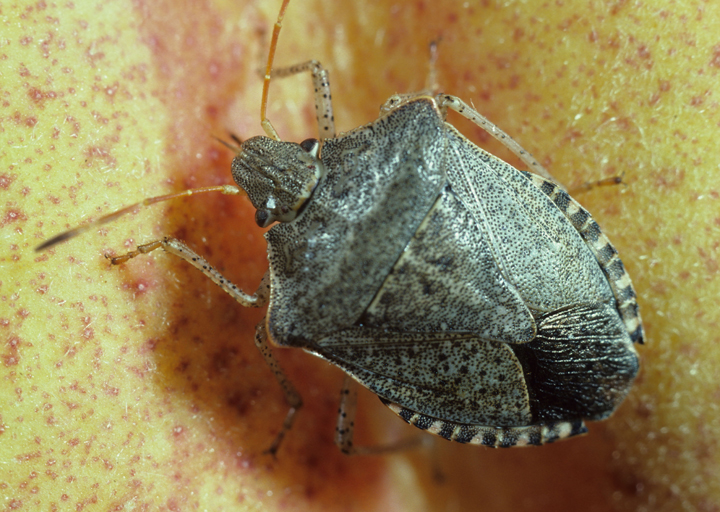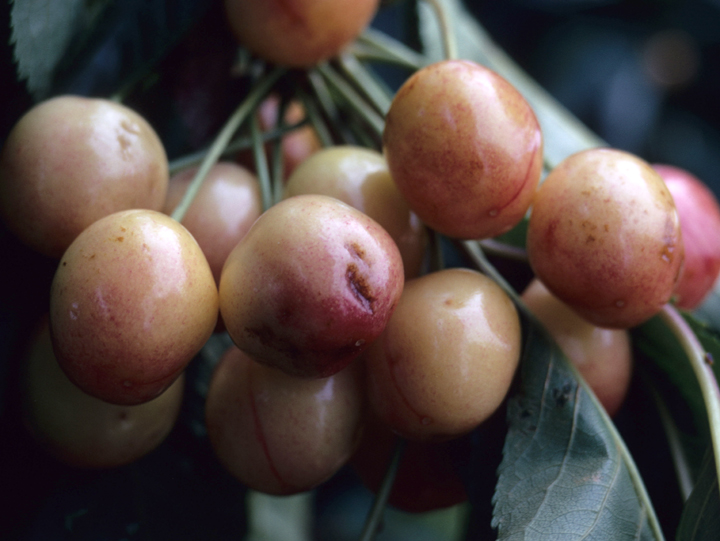by T. W. Anthon & Elizabeth H. Beers originally published 1993; revised December 2007 by Christian Krupke
Consperse stink bug
Euschistus conspersus Uhler
Green stink bug or Green soldier bug
Acrosternum hilare (Say)

Stink bugs are sporadic pests of most deciduous tree fruits and can occasionally cause severe damage. The name stink bug comes from the insects’ habit of exuding a fluid, which has a strong and usually disagreeable odor, from glands between the legs.
There are more than 200 species of stink bugs in North America. Adults are usually some shade of green, tan, or gray-brown. Many feed on plants, but a few are predaceous (see rough plant bugs Brochymena sp. in Other Predatory Bugs). The two most common stink bugs in apple and pear orchards are the consperse stink bug and the green stink bug. The redshouldered stink bug (Thyanta accerra), Say stink bug (Chlorochroa sayi) and the onespotted stink bug (Euschistus variolarius) will also attack tree fruits.
Hosts
The green stink bug is a pest of several crops other than tree fruits, such as alfalfa, beans and cotton. It also survives and reproduces on many uncultivated plants, such as mullein, mustard and dock. Consperse stink bug attacks many weeds (mustards, dock, mallow, plantain), shrubs (blackberry) and vegetables. Damage on almonds has also been noted.
It is uncertain whether or not nymphs of stink bugs can survive on tree fruits. Observations indicate that although eggs are laid and will hatch, the nymphs do not survive for any length of time. The primary concern is for adults migrating in from herbaceous hosts and feeding during either late spring or close to fruit harvest. Damage has been observed on apple, pear, cherry, peach, apricot and plum.
Life stages
Consperse stink bug
Egg
The egg is barrel shaped. It is pearly white at first but turns pink. On top of each egg is a circle of white projections. Eggs are laid in clusters.
Nymph
The nymph develops through five instars. The color of young nymphs can vary from black to white with reddish markings. Older nymphs have yellow and brown bodies with black markings.
Adult
The adult is shield-shaped and about 1/2 inch (12 mm) long. It is pale brown with small black specks on the back, yellow beneath, and red antennae. The black specks help distinguish it from the predaceous Brochymena stink bug species, which are gray with white specks.
Green stink bug

Egg
The egg is barrel shaped. Eggs are laid in clusters of about 30 to 40 on the undersides of leaves.
Nymph
The color of the nymph varies from instar to instar and from individual to individual. Young nymphs are generally dark with red or orange markings. Older nymphs are mostly green, with orange markings at the edge of the thorax and abdomen and several large black disks down the center of the upper surface of the abdomen. The first instar is 1/25 to 1/17 inch (1 to 1.5 mm) long, and the fifth instar is 2/5 to 1/2 inch (10 to 13 mm) long.
Adult
The adult is 1/2 to 3/4 inch (14 to 18 mm) long and is a bright green. It has inconspicuous yellow-orange and black markings along the lateral edge of the abdomen. The lateral margins of the head and thorax are yellowish.
Life history
Adults overwinter beneath weeds or honeysuckle on the orchard floor or in protected places outside the orchard such as brush piles or bin stacks. They become active in April and feed on broadleaf weeds either in or outside the orchard, usually when the trees are in the pink to early bloom period. Females lay eggs on the leaves of host plants. Some stink bugs move into orchards as soon as they emerge in the spring and deposit eggs on fruit trees. When this happens, fruit can be damaged by feeding nymphs.
Adults often migrate to orchards in late summer from surrounding areas in search of moisture when uncultivated vegetation starts to dry. Trees in outside rows are likely to be the most severely damaged. Eggs for the second generation are usually laid on broadleaf plants in the cover crop. There are 2 or 3 overlapping generations each season. Adults seek overwintering sites in October or before fall frosts.
Damage
Pome fruits
Adults puncture fruit with their beaks and feed in the fruit flesh. The puncture may not be visible, but the surrounding area is sunken and often dark green. Beneath the skin is a group of loose spongy cells, often with brown discoloration. Damage looks similar to the disorder bitter pit, but bitter pit tends to be around the bottom of the fruit, while stink bug damage is typically around the top. Also, bitter pit produces a mass of corky brown cells beneath the skin, whereas the spongy cells caused by stink bug injury are only slightly discolored. Pome fruits tend to be damaged in late summer as they approach maturity.
Peaches
Feeding of adults causes cat-facing or dimpling on fruit. If fruit is almost mature when injured, the flesh does not turn corky but begins to decay. Damage on peaches is more noticeable than on apples or pears.
Cherries
Early season feeding causes cat-facing, dimpling and deformity. Feeding later in the year discolors the flesh around the pit. Because the damage is not visible from the outside, cherries with this type of injury are generally not sorted out during packing.
Monitoring
Stink bugs are easy to see on trees because of their large size. However, they will quickly move to the opposite side of the fruit when disturbed. Look also for spots of excrement, which they deposit while feeding. They can be found in beating-tray samples, but this method is not practical when fruit nears maturity, as more fruit than bugs will drop onto the tray. If the orchard has a history of stink bug damage, herbaceous hosts at the orchard borders can be swept with a canvas sweep net.
Biological control
Telenomus podisi and T. utahensis, two scelionid wasp egg parasitoids, will help suppress stink bug populations.
Management
It is difficult to detect and control stink bugs because of the sporadic nature of damage and problems involved with sampling. Adults usually migrate into orchards from nearby uncultivated plants when they dry out. Damage will usually be concentrated at borders near wild hosts, and spot treatments or border treatments can be effective. If the orchard has a history of damage, be on the alert during critical times of the season (fruit set on cherries and late summer on apple and pear). Although a number of materials will kill stink bugs on contact, providing residual control of new migrants is difficult. Treatments may have to be repeated as adults continue to be found.
Stink Bug Gallery
Materials available for apple
Excerpt from the WSU Crop Protection Guide. For timings at which each pesticide can be used refer to the Crop Protection Guide.
Materials available for pear
Excerpt from the WSU Crop Protection Guide. For timings at which each pesticide can be used refer to the Crop Protection Guide.
Use pesticides with care. Apply them only to plants, animals, or sites listed on the labels. When mixing and applying pesticides, follow all label precautions to protect yourself and others around you. It is a violation of the law to disregard label directions. If pesticides are spilled on skin or clothing, remove clothing and wash skin thoroughly. Store pesticides in their original containers and keep them out of the reach of children, pets, and livestock.
YOU ARE REQUIRED BY LAW TO FOLLOW THE LABEL. It is a legal document. Always read the label before using any pesticide. You, the grower, are responsible for safe pesticide use. Trade (brand) names are provided for your reference only. No discrimination is intended, and other pesticides with the same active ingredient may be suitable. No endorsement is implied.
Articles from the Tree Fruit website may only be republished with prior author permission © Washington State University. Reprint articles with permission must include: Originally published by Washington State Tree Fruit Extension Fruit Matters at treefruit.wsu.edu and a link to the original article.





